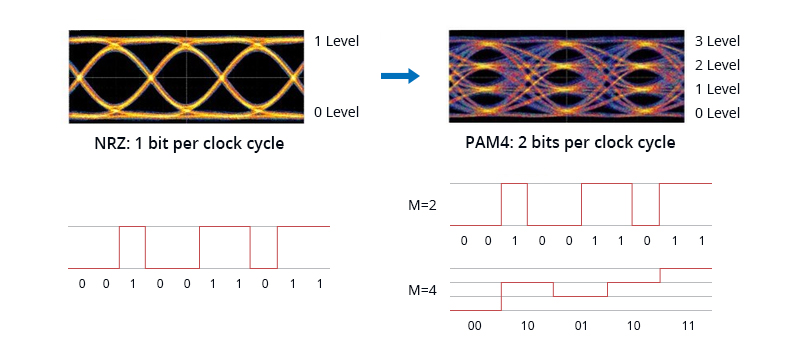PAM4 in 400G Ethernet application and solutions
400G PAM4 (4 Pulse Amplitude Modulation) is the modulation technology that fits for high-speed signal interconnection in the next-generation data center, paving the way to 400G Ethernet in data centers. What is 400G PAM4? Why is it chosen to be applied to 400G Ethernet? Find answers here.
What Is PAM4 for 400G Ethernet?
Pulse Amplitude Modulation 4-level (PAM4) is a technology that uses four different signal levels for signal transmission and each symbol period represents 2 bits of logic information (0, 1, 2, 3). By transmitting two bits in one symbol slot, PAM4 halves the signal bandwidth. Therefore, it is feasible to increase bandwidth by using advanced modulation PAM4 technology to increase the data rate without having to configure the data center with more fibers. 400 Gbps Ethernet can be realized with four lanes of PAM4 (8× 50 Gbps). This effectively doubles a network’s data rate, enabling 400G PAM4 for short-haul and long-haul transmission.
Why Does 400G Ethernet Need to Use PAM4 Technology?
In terms of supporting 400G Ethernet speed, the transmission rate of NRZ 25Gbps single channel has reached its limit, which cannot be adapted to the development of current high-density data centers. When discussing the 400GE IEEE 802.3bs standard, it was proposed to replace NRZ with PAM4 technology. So why is 400G PAM4 technology a viable alternative to NRZ?
Benefits of 400G PAM4
PAM4 modulation replaces 400G Ethernet using 16×25G baud rate NRZ and provides a path from 100G Ethernet using 4×25G baud rate to 400G Ethernet through 8×25G baud rate architecture. It is called 400G Ethernet The link adopts the 8×50G bit rate solution, reducing not only the fiber cost but also the link loss. For hyper-scale data centers, it's time for them to transition from the previous 100G or Gigabit networks to 400G PAM4 Ethernet for faster transmission efficiency.
Compared to the NRZ signal, PAM4 has some better advantages. PAM4 carries 2 bits per symbol and transmits twice the NRZ information per symbol period. Hence, PAM4 doubles the bit rate for a given baud, thereby bringing higher efficiency to 400G transmission with greatly reduced signal loss. This key benefit of PAM4 allows existing channels and interconnects to be used at higher bit rates without doubling the baud rate and increasing channel loss.
PAM4 vs NRZ

Figure: PAM4 vs NRZ
Double Bit Rate - PAM4 doubles the bit rate for a given baud rate over NRZ. Thus, a 28 Gbaud PAM4 signal can deliver the same bit rate as a 56 Gbaud NRZ signal.
Less Signal Loss - PAM4 should let you develop 56 Gbps data lanes with less signal loss than would occur by simply doubling the NRZ (sometimes called NRZ-PAM2) bit rate. Exotic PCB materials can compensate for the deficiencies, but at a cost few are willing to pay.
400G PAM4 Transceivers: Multi-mode vs Singlemode
The 400G QSFP-DD transceivers modulation method uses PAM4 technology, including multi-mode and single-mode. In addition, the electrical port side of the 400G optical module supports 8x50G PAM4 modulation, and the optical port side supports both 8x50G PAM4 and 4x100G PAM4 modulation.
Both 400G SR8 and 400G SR4.2 multimode optical modules support 8x50G PAM4. 400G SR8 optical modules can use MPO-16 connectors or MPO-24 connectors to connect 8 pairs of fibers. The 400G SR4.2 modules use MPO-12 connectors, and the wavelengths are bidirectional and multiplexed.
According to the above mentioned, in the single-mode 400G optical module, the electrical port side is modulated with 4x100G PAM4, and a group of the optical port side is modulated with 8x50G PAM4. There are three common 8x50G PAM4 400G optical modules: FR8, LR8, and 2xFR4. 400G FR8 and 400G LR8 are the earliest available 400G single-mode interfaces, 8 wavelengths are multiplexed into one fiber, and duplex LC light is used at the same time. interface. The 2xFR4 400G optical module uses 8 lasers but is divided into two groups of 4 wavelengths according to the 200G FR4 standard.
400G optical modules modulated by 4x100G PAM4 are the focus of the current market, including 400G DR4, 400G FR4, and LR4, and their line-side uses four channels of 100G PAM4. In the 400G DR4 optical module, the DSP converts the 8x50G PAM4 electrical signal into 4x100G PAM4 and then transmits it to the optical engine.
Transceiver Solution Based on 400G PAM4
PAM4 is a relatively low-cost solution for 400GbE and data centers that has been adopted by the transceiver industry, enabling high-speed data rates, moving toward 400G and beyond. FS 400G transceivers apply 4×100G PAM4 or 8×50G PAM4 technology, which have been standardized by the IEEE working group, including 400GBASE-SR8, DR4, LR8, ER8, XDR4, FR4, and LR4. The FS 400G transceivers use a pluggable double-density design to support transmission requirements of different distances. At the same time, they can perform signal conversion through PAM4, and use multiplexing technology to convert transmission channels to achieve reasonable distribution of data center fiber resources.
| Standard | Transceiver Types | Link Distance | Media Type | Lanes | Power Consumption |
|---|---|---|---|---|---|
| IEEE P802.3cm | 400GBASE-SR8 | 100m | MMF | 8× 50G PAM4 | <10W |
| IEEE 802.3bs | 400GBASE-DR4 | 500m | SMF | 4× 100G PAM4 | <10W |
| 400GBASE-LR8 | 10km | SMF | 8× 50G PAM4 | <14W | |
| IEEE P802.3cn | 400GBASE-ER8 | 40km | SMF | 8× 50G PAM4 | <14W |
| 100G Lambda MSA | 400GBASE-XDR4 | 2km | SMF | 8× 50G PAM4 | <12W |
| 400GBASE-FR4 | 2km | SMF | 4× 100G PAM4 | <12W | |
| 400GBASE-LR4 | 10km | SMF | 4× 100G PAM4 | <12W |
Conclusion
As the market moves to PAM4-based modulation, more and more chip makers and transceiver vendors are manufacturing new 400G products using PAM4, transferring 400G PAM4 from theory to practice. PAM4 400G based on 50G PAM4 or 100G PAM4 will certainly become the basic rate of the next-generation Ethernet and stand out with its high performance and potential.
You might be interested in
Email Address

-
PoE vs PoE+ vs PoE++ Switch: How to Choose?
May 30, 2024















